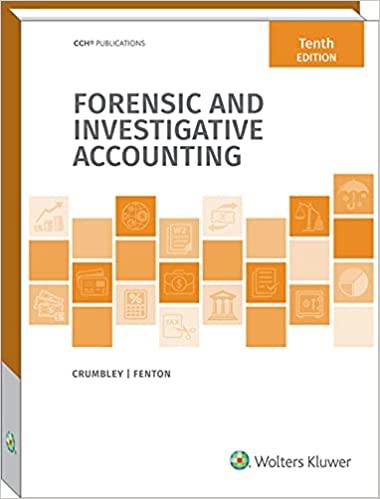Question
1.Brown, Izan and Loh (1992) found that revaluations are more likely to take place: Multiple Choice in small firms with low value assets that wished
1.Brown, Izan and Loh (1992) found that revaluations are more likely to take place:
Multiple Choice
- in small firms with low value assets that wished to borrow more.
- in industries that are strike prone and in entities that are highly geared.
- in industries that are strike prone.
- in entities that are highly geared.
2. Casey Co Ltd is assessing the recoverable amount of some land it invested in 5 years ago at a cost $600 000. Management has sought independent valuation advice that indicates that the land may be sold in 6 years' time for $800 000. Since the land is not generating any cash flows, this is its undiscounted recoverable amount. The appropriate discount rate is estimated to be 7%. The present value of $1 received in 6 years' time at a discount rate of 7% is 0.6663. What is the effect of using the discount rate on the need to write down the value of the asset?
Multiple Choice
- The undiscounted amount may not be used according to AASB 136 so the asset should be written down by $66 960.
- There is no need to write down the asset in either case since the undiscounted amount is greater than the cost and the discounted amount of $900 438 is also greater than the cost.
- Since the recoverable amount of $800 000 is greater than the cost of $600 000, there is no need to write down the asset.
- The undiscounted amount may be used in this case as the asset will not be continually in use, and therefore 'value in use' cannot be calculated. As this amount is higher than the cost there is no need to write down the asset.
3. By permitting some classes of assets to be valued at cost and others at fair value the AASB has:
Multiple Choice
- removed any confusion regarding the total balance of non-current assets.
- created a situation where the total asset figure may be a combination of cost and fair value assessments, reducing its meaningfulness.
- removed the opportunity for managers to act in their own self-interest as suggested by Positive Accounting Theory.
- forced entities to accurately reflect their true financial position at any point in time.
4. According to Positive Accounting Theory, the size of the entity may have an impact on management's decision to revalue because of management's motivation to reduce political costs. There is more than one possible view regarding the effect of revaluation on political visibility, including which of the following?
Multiple Choice
- Where revaluations increase the size of the asset base, the return on assets will be lower and this will potentially lower political costs.
- Since revaluations may increase the variability of asset size, they will increase political costs.
- Where revaluations result in an increase in the asset base, depreciation expense will increase and lead to greater political costs.
- Where increases in asset size are expected to result from revaluations, the increase in the size of the entity may reduce political costs.
5. Where an asset's carrying amount based on its cost is written down to its recoverable amount, AASB 136 specifies that:
Multiple Choice
- since this constitutes a revaluation of the asset, all assets in that class must be revalued.
- to the extent that the asset was revalued upward in the past, the amount of the write-off may be transferred to the revaluation surplus and any remaining amount should be expensed.
- the amount written down is to be treated as an adjustment to the revaluation surplus.
- the write-down is not considered to be a revaluation, so the entity is not obliged to revalue that whole class of non-current assets.
6. rofit on the sale of an asset is calculated:
Multiple Choice
- once depreciation has been applied to the date of sale.
- by subtracting the updated carrying amount from the net proceeds on disposal.
- after assessing the fair value of the asset and subtracting the proceeds on the sale.
7. In accordance with AASB 116, the depreciation method applied to an asset shall be reviewed:
Multiple Choice
- at least at the end of each annual reporting period.
- every 3 years.
- as determined by the company directors.
- as and when required.
8. Where an asset is revalued, the treatment of depreciation is to:
Multiple Choice
- recalculate and charge it to the income statement based on the revalued amount for the asset and the revalued residual value.
- charge the original amount of depreciation to the income statement and calculate the new depreciation based on the revalued amount and treat it as a special item.
- recalculate and charge it to the income statement based on the revalued amount and the original residual value.
- charge the original amount of depreciation to the income statement and transfer any change in value to the asset revaluation reserve.
Step by Step Solution
There are 3 Steps involved in it
Step: 1

Get Instant Access to Expert-Tailored Solutions
See step-by-step solutions with expert insights and AI powered tools for academic success
Step: 2

Step: 3

Ace Your Homework with AI
Get the answers you need in no time with our AI-driven, step-by-step assistance
Get Started


